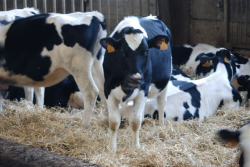Context
At present, few studies have been led on the dairy cattle welfare. A project of recommendation concerning the protection of cattle was however set down to the advice of Europe. The CRA-W wishes to invest in this type of research while starting with the survey of one particularly stressful moment for the dairy heifer; the first calving. To the stress bound at the calving are added those indeed relative to the integration of the animals in the herd of the production cows, to the first milking, to the change of food and to an environment sometimes very different (DAC, type of housing,…).
Objectives
The objectives of this study are to evaluate the stress of the heifers at the first calving as having resorts to behavioural analyses and the physiological measures, as well as to evaluate the interest to adapt the heifers to the herd of the dairy during 10 days, in order to familiarize them to this new environment. This adaptation is operated one month before the date presumed of the calving.
Expected results
Results obtained
The results concern 2 groups of 2 heifers, and should be confirmed in the future. They suggest that the animals adapted to the dairy herd before the calving lie down more between 8h00 and 16h00 (29 vs 19% of the time, P = 0.002) and benefit the straw area more (53 vs 34% of the time, P <0.001) that the animals raised in a conventional way. However, this difference of behaviour cannot be imputed entirely to the adaptation of the animals before the calving, since their bodily weight was superior of 20% compared to the other animals. Nevertheless, the difference of behaviour was reflected in the dosages of salivary cortisol during the 7 days after the calving. At this moment indeed, the animals having been adapted to the herd have a salivary cortisol content lower to the others (73.61 vs 93.04 ng%, P = 0.011). The results also show that the adaptation of the animals before the calving didn't permit to have a better frequentation of the DAC at the beginning of the lactation. The results must be confirmed on a larger number of animals. The dosages of the hydroxybutyrate and glucose in blood will also bring information on the relation between the body reserve mobilization in beginning of lactation and the post - calving stress. The dairy production data and the evolution of the body weight of the animals will be studied in the future.
Contribution
Projext leaderPartners
University of Liège, Department of functional sciences, Faculty of Veteriny Medecine, Boulevard de Colonster, 20 B41, 4000 Liège (J. Sulon)
CRAW off coordinator
Dr. Eric Froidmont
CRA-W
Tél. : +32 (0)81 62 67 74
Fax : +32 (0)81 61 58 68
Email : froidmont@cra.wallonie.be
Funding
- CRA-W - Walloon Agricultural Research Centre



